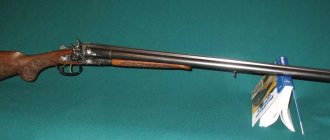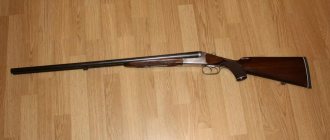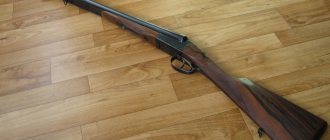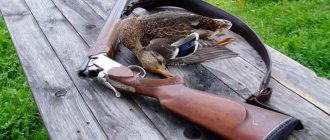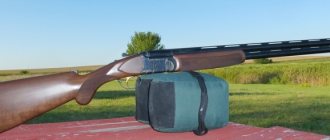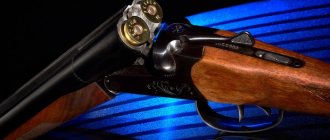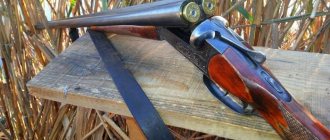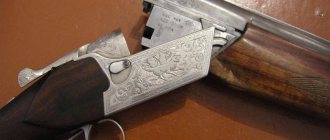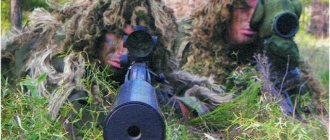The TOZ-34 hunting rifle can easily be considered legendary. This Tula vertical double-barreled shotgun has been produced at the enterprise for more than 50 years. Over so many years of production, the TOZ-34 gun has been produced in millions of copies.
The TOZ-34 brand shotgun is a light hunting weapon with a low-set barrel. It is distinguished by its original design, reliability in use, high accuracy when shooting and excellent balance. This vertical is considered the most famous domestic development, in particular in the USSR.
The TOZ-34 is a typical workhorse, a gun equally suitable for any hunting. It's light enough for trail hunting, has a good punch for fly hunting, and an accurate second shot, making it an excellent sporting shotgun. Some hunters successfully catch ungulates with them, including large ones.
History of the development and creation of TOZ-34
The TOZ-34 shotgun was developed at the Tula Arms Plant back in 1964 by a young talented designer Nikolai Ivanovich Korovyakov.
An interesting fact is that N.I. Korovyakov did not have a special technical education and was not a professional gunsmith. Perhaps this is what allowed him to move away from generally accepted clichés and create a gun with a truly original design. Designer Korovyakov was not afraid to experiment and found interesting, non-trivial ideas.
In 1965, the TOZ-34 gun won a gold medal at a specialized exhibition at the Leipzig fair for its original design.
Since 1968, the gun has been produced as a piece, and since 1969 it has been put into mass production. Immediately after the launch of the gun into mass production, a modification of the TOZ-34E gun appeared, with an automatic cartridge ejector (ejector).
The TOZ-34 shotgun quickly gained popularity among Soviet hunters, both amateurs and commercial hunters. This was the first model of a Soviet gun with vertically positioned barrels, characterized by versatility and light weight.
Most hunters know the TOZ-34 as a 12-gauge gun, but at one time guns of other calibers were also produced: 16, 20, 28 and even 32. Guns of these calibers were produced in small quantities, they were made on a 12-gauge block and were not in particular demand among hunters because of its heavy weight.
Currently, the TOZ-34 gun has been produced for more than 50 years, during which time more than a million guns of various designs have been produced.
According to the manufacturer's warranty, the lifespan of the TOZ-34 gun is 12 thousand shots, but in practice, most guns can easily withstand 20-30 thousand shots. According to rumors, there are TOZ-34 shotguns that have fired 100 thousand rounds and continue to work properly.
The Tula Arms Factory developed and even produced several models of smoothbore guns, which were supposed to replace the legendary TOZ-34: TOZ-84, TOZ-91, TOZ-120, TOZ-200, but all of them could not even come close to matching in popularity among hunters with TOZ-34.
Weapons connoisseurs advise buying TOZ-34 shotguns produced from 1970 to 1990, as well as those produced after 2000, on the secondary market. Shotguns of these years of production are made of high-quality materials, have a higher quality of fitting of parts and better build quality.
Description and appearance
TOZ-120 is a modern hunting rifle, developed on the basis of TOZ-91 weapons with an improved design. Initially, TOZ engineers set themselves the goal of creating a replacement for the outdated but beloved TOZ-34, so it is not surprising that many buyers compare the new model with the famous “vertical”. From the TOZ-91, the gun took only the best design advantages: the firing mechanism, the principle of barrel soldering, and so on. Also, the new model was freed from the shortcomings that were present in the old TOZ-34.
TOZ-120 also received major changes in appearance. PJSC "Tula Arms Plant" has long realized that you can make good money if you produce not only high-quality, but also beautiful weapons. So connoisseurs will be pleased with the large number of engravings on both metal and wooden stocks. Especially wealthy hunters can take advantage of the opportunity to make an individual order so that the rifle acquires gold and silver inserts, precious stones or personalized carving.
The new double-barreled shotgun differs from the TOZ-91 and TOZ-34 only in one trigger (switching between barrels occurs using a special lever). Also in the 120 model, a selector switch appeared, combined with a safety button. The first serves to disable the barrel locking mechanism if it is necessary to remove entire cartridges. The second is a much more convenient version of the fuse than the classic flag. The weapon has become not only safer in terms of operation, but also much more convenient.
General description of TOZ-34
Compared to single-barreled hunting weapons, double-barreled guns have a number of advantages:
- You can quickly fire a second shot from a double-barreled shotgun without wasting time reloading the weapon.
- Their reliability is significantly superior to automatic weapons, since the design of double-barreled guns is extremely simple.
- In most cases, double-barreled shotguns have better balance than single-barreled shotguns.
- The weight of a double-barreled shotgun is significantly less than the weight of automatic shotguns.
Although new models of shotguns are superior to the TOZ-34 in some respects, in those years it was the undisputed leader among double-barreled guns.
The characteristics of TOZ-34 differ in the following parameters:
- High accuracy of weapons.
- Excellent application.
- Excellent balance.
The combination of these parameters made the TOZ-34 a real legend of Soviet hunting weapons. TOZ-34 shotguns are still produced in several versions, the most popular of which are the TOZ-34 12-gauge shotguns. A one-piece souvenir double-barreled shotgun is perfect for a gift. It is decorated with chasing and interesting engraving.
Despite all the advantages of this model, experts recommend purchasing TOZ-34 from early years of production, or rather before 1990, since after the collapse of the USSR, the quality of assembly and processing of parts of these guns decreased significantly, the plant began to pursue quantity rather than quality.
Advantages and disadvantages
This is not to say that the TOZ-120 gun is ideal. However, given the extensive list of positive aspects the model has, it is not surprising that many owners think so. Here are just a few points to pay attention to:
- Accuracy of battle. This parameter largely depends on the choke used, but on average it is about 65%, provided that a shot cartridge with an average powder load is used at a distance of 35 meters. For comparison: the performance of sports models is usually no more than 50%, so hunters are even in the black.
- Lots of weapons. Agree that it is better to move through the forest with a light TOZ-120 than with a heavy and clumsy IZH-27. Due to the fact that the weight of most models does not exceed 3.3 kg, the hunter does not get so tired during fishing, and also gains additional mobility when aiming.
- Reliability. Due to the fact that many modifications use an ejector to eject ammunition, the TOZ-120 gun can be used in almost any weather conditions (from –50 to +50 degrees Celsius). Also, the gun is not afraid of humid climates, since it has a chrome and nickel coating on the barrel.
- Barrel switching mechanism. Many hunters are inclined to believe that such a system is much more convenient than two triggers. The TOZ-34 also had modifications that had a similar function (they were marked “1C”), but in the new double-barreled shotgun it is considered something of a standard, so you don’t have to buy an upgraded model.
- Wide selection of choke constrictions. Thanks to this feature, the hunter can configure the rifle the way he wants. Now you don’t have to make adjustments for range or experiment with different shot loads before hunting. It is enough to set the optimal choke or pay and it’s in the bag.
We could also mention many positive aspects (the quality of the wooden stock, the chamber of different lengths, a modern extractor, and so on), but it’s time to talk about the shortcomings of the TOZ engineers’ weapons:
- The forend is too thick. Many hunters complain that holding a weapon with their left hand is not very comfortable. This is especially true for those owners who have relatively small hands, for example, teenagers and women.
- The system of fuses and barrel locking is too complex. Because of this, various problems may arise related to disassembling and assembling weapons. It would be much better to use the system that is present in guns from the Izhevsk Mechanical Plant.
- Despite the fact that artistic engraving and notching have appeared on standard guns, its quality leaves much to be desired. Of course, this does not apply to piece samples, which are made perfectly.
Piece shotgun TOZ-120-12M-1ES
Compared to the advantages, the TOZ-120 has much fewer disadvantages, and they don’t sound so scary. That is why the gun became popular among hunters. Even the legendary TOZ-34 had a serious problem with the low quality of springs in the trigger. There are no shortcomings of this magnitude here.
Design
Despite the fact that the TOZ-34 sideflint has been produced since 1969, the uniqueness of its design has not yet been repeated in any modern model. Although the model has one serious drawback, expressed in the weakness of the mainsprings, it is still quite popular due to its lightness, simplicity of design and high service life. You should not shoot the TOZ-34 with reinforced cartridges (for example, Magnum), this can lead to damage. Although TOZ-34 barrels are quite reliable, powerful cartridges often lead to cracking of the pistol grip.
The vertical barrels of the gun are easily removed. They are fastened with a coupling and strips. The barrel channels are chrome-plated, which improves the accuracy of the TOZ-34 combat. The narrowing of the barrels of a classic double-barreled shotgun is different, the upper one is 1 mm, and the lower one is 0.6 mm.
The barrels of the weapon are connected to the receiver according to a unique design. For this purpose, the TOZ-34 design uses ring hinges, which are partially cut off so that the barrels can be disconnected.
The chrome-plated chamber allows the use of cartridges with a 70 mm sleeve. Spent cartridges are removed in various modifications according to different schemes:
- In the classic TOZ-34 gun they are extended due to the operation of the ejector;
- In TOZ-34E, the cartridge case is automatically ejected due to the operation of the ejector. Moreover, only the spent cartridge case is ejected, and the whole cartridge in the other barrel moves out only a little.
The TOZ-34 trigger mechanism is mounted on a separate base and has internal triggers. The TOZ-34 has 2 triggers, each responsible for its own barrel. To ensure safety when handling the gun, the design includes special trigger interceptors. There is also a fuse in the design that locks the sear. The front safety position means “fire”, the rear “safety”. The right side of the receiver has a special flag that serves to simplify the disassembly procedure of the gun.
The integral forend consists of two parts, each of which is attached to the gun with screws. The stock neck has a pistol shape, which ensures comfortable holding of the gun in your hands when shooting. The stock itself is made from various types of wood.
Modifications of TOZ-120
Despite the fact that not much time has passed since the release of the TOZ-120, the weapon has already acquired six official modifications, developed to suit the preferences of hunters. Here is a brief description of these versions:
- TOZ-120-12-1E is a version of the standard model, equipped with an ejector mechanism. The modification was developed for Siberian hunters who were constantly faced with the fact that they could not remove a spent cartridge case in severe frost. Now a special extractor will do all the work of releasing the used cartridge for the hunter. Spent cartridges will be released from the chamber even if the metal is very cold.
- TOZ-120-12M-1E is one of the first official modifications, which not only has an ejector mechanism, but is also designed to fire magnum cartridges. Standard ammunition can also be used, but the best accuracy will be shown by the cartridge that has a reinforced powder load, because the chamber size is limited to 76 millimeters.
- TOZ-120-12V-1E is the first modification that includes replaceable muzzle inserts (choke and choke), and is also distinguished by the presence of an extractor. The gun was specially designed for those hunters who lack standard accuracy, but do not want to use reinforced magnum cartridges. The gun uses standard 12/70 ammunition for shooting, but the accuracy rate is increased by 10% (poluchok) and 15% (choke).
- TOZ-120-1MV-1E is the most modern modification at the moment. From the name it is clear that it includes everything that previous versions included: a mechanism for ejecting spent cartridges, several choke constrictions, and the ability to fire magnum cartridges. At the moment, this version is the most preferred for hunting, because it has flexible customization options.
Hunting rifle TOZ-120-1MV-1E
- TOZ-120-2E is another relatively recent version, which is distinguished by the presence of a second generation ejector. The gun is distinguished by a much better mechanism for ejecting spent cartridges, but at the moment it is not particularly popular among hunters due to its high cost. Although the extractor began to work much more stable, practically without misfires.
- TOZ-120-1EP is a gift version of the gun, supplied in a metal case, and also has a unique appearance with gold or silver frescoes. The gun is also distinguished by higher quality assembly and special attention to even the smallest details. The wooden stock and stock are made of birch covered with red varnish, making the model look even more sophisticated than before.
Well, don’t forget about the opportunity to carry out an independent upgrade. For example, on a TOZ-120 gun you can install an optical or collimator sight, attach an under-barrel flashlight or bayonet, replace the wooden stock and butt with plastic analogues, and so on. Fortunately, the weapon is an excellent base for independent tuning.
Principle of operation
The original solution that was used in the development of the TOZ-34 double-barreled shotgun resulted in an atypical interaction between the parts of the gun that are involved in the process of opening and closing the barrels. At the same time, the use of such an atypical scheme made it possible to significantly increase the service life of the gun and make it practically trouble-free.
In order to open the barrels, you need to move the lever responsible for locking the barrels all the way to the right. When pressed, the lever acts on the locking frame, moving it out of the groove. At the same time, the triggers are pressed out. When the triggers are pressed, they release the strikers, which are pressed behind the plate under the influence of springs.
Since the cocking lever has a stop with the box, when opening the barrels they do not rotate. When the hammers are cocked, this pushes the cocking indicators up, which in turn serves as a signal that the hammers are cocked. When the gun is opened, the upper bevels of the box act on the ejector, which extends along with the cartridges, ejecting them.
When the opening procedure occurs, the triggers remain cocked. This movement affects the cocking lever. The frame locking the barrels is released, locking the barrels, after which the locking lever returns to its original position. If the lever does not return to its place on its own, it must be moved there using your hand.
To fire a shot from the TOZ-34, you need to remove the gun from the safety catch, take aim and pull the trigger.
After shooting, the gun is thoroughly cleaned of carbon deposits and placed in a safe for storage. The TOZ-34 should be stored unloaded and with the triggers pulled. Failure to release the triggers may weaken the springs.
Device
A small front sight and rear sight were placed on a detachable barrel with a chrome-plated channel and chamber, which is attached to the breech via a dovetail groove. Unlike TOZ-18, in this model the barrel is locked using a movable frame.
It opens after pressing the lever, after which this frame will move to the side and stand on the stopper. It is pressed out by the barrel hook when the shooter begins to close the barrel. The spring of the lever will begin to act on the frame, as a result of which it will go beyond the cutout of the hook and lock the gun. A similar design, according to experts, is used in many “double-barreled guns”. A conventional ejector (extractor) is responsible for moving the cartridge case out of the chamber.
Specifications
TTX TOZ-34 looks like this:
- Caliber: 12, 20, 28;
- Cartridge: 12/70, 20/70, 28/70;
- Barrel length with caliber 12 and 20: 711 millimeters;
- Barrel length with caliber 28: 660 millimeters;
- Gun length 12 and 20 gauge: 1160 millimeters;
- Length of 20 gauge shotgun: 1110 millimeters;
- Weight: 3300 g;
- Muzzle constriction top: choke;
- Muzzle constriction bottom: pay;
- .
| Characteristic data | Indicators | Comparative data with other simple guns for hunting |
| Weight | 3.2 kg | Lighter than the rest |
| Gun length | 1.1 m | Typical |
| Barrel length of TOZ 34 12 gauge | 660-711 mm | Typical |
| Chamber length | 70 mm | Standard |
| Combat resource | 12,000 shots | Elevated |
| Accuracy | At the top - 60, at the bottom of the barrel - 50 from 35 m in a 7.5 mm target | Increased |
| Calibers | 12, 16, 20, 28, 32; 5.6 mm, 9.53 mm | In priority |
| Ammo | Buckshot, shot or bullets with a case size of 70 mm, they are made of plastic, metal and paper | Standard |
The parameters of a hunting smoothbore weapon depend on the making of the barrel channels and their relative position. In the case of TOZ-34, they are located vertically. It is worth briefly mentioning the muzzle constriction; this is a characteristic of a smooth-bore weapon that affects the spread of the shot along the cone.
Accuracy parameters for 12 gauge:
| Execution | Upper barrel, range 35 m, target diameter 750 mm, % | Lower barrel, range 35 m, target diameter 750 mm, % |
| TOZ-34, ordinary and ornamental | 60 | 50 |
| TOZ-34, piece and souvenir | 65 | 55 |
The weight of the TOZ-34 weapon is 3.15 kg, with good balance. Which in turn allows you to achieve good accuracy when shooting offhand.
It should be noted that when using metal cartridges, the accuracy of the weapon is slightly reduced. Also, changes in accuracy are noted when using ammunition from different manufacturers.
Self-loading of cartridges must be done in a dry place, without open sources of fire.
Trigger double-barreled shotgun with the symbol "B"
According to Blum and Shishkin, the trigger double-barreled shotgun under the symbol “B” was created in 1885 by designer A.D. Ivanov. But it began to be mass-produced only in 1906. It was manufactured until 1914, then from 1925 to 1941, and in the last series - from 1956 to 1960.
I'm wondering where has this model been these 20 years after its invention? And is Tula really an invention? Now we will try to dot all the i's. The fact is that I had to repair double-barreled trigger guns that were similar in construction, design, and even individual components. But... Belgian production. Moreover, one had Damascus trunks. However, the block and short shank were exactly like those on model “B” from about 40 years of the last century, but the marks on this double-barreled shotgun were all Belgian, from the Liege manufactory. So I'm not sure that the B model is a Russian invention. Most likely a fake, or a “pirated copy” as they call it today.
However, whether Model B is a fake or not, it has proven itself to be excellent throughout its existence. What kind of model was this? Caliber - 16, 20, extremely rarely 12. Weight 2.75-3.25 kg. Barrel length 700-725 mm, drilling: right barrel cylinder with pressure; left choke, chamber length 70 mm, barrels not chrome plated. The diameter of the striker is 2.5 mm. Protrusion of the strikers from the block shield is not allowed. Trigger force: front trigger 1.5-2.75 kg; rear 1.75-3.0 kg.
The barrels in the “B” model are detachable, and were made in several versions. At the time when the model first saw the light, the barrel tubes were solid, and a pad (platform) with hooks was soldered to them from below with brass solder, and a Grinner bolt eye was soldered to the top. Next, the sighting bar and the bottom bar were soldered with tin. I must note that these barrels were quite heavy, but had an excellent action. The fact is that the eye of the Grinner bolt was strong and not weakened at the bottom, as was later done on the latest models BM, TOZ-63, etc. In model “B”, ruptures of the eye (at the bottom) were completely eliminated. The barrels were made of 50PA steel. To tell the truth, it was a slightly improved quality of 45 steel. It also corroded on the inside, and the barrels had to be constantly cleaned. And from the use of brass cartridges with CB primers, such barrels were completely covered with shells. But those who used folder sleeves can still save such barrels, even now.
However, there was another type of barrel for TOZ-B. They are dated 1947. Here the barrel tubes are already pressed into a breech coupling, which protrudes several millimeters above the barrel tubes. This, of course, greatly spoiled the design of the barrels, and it looked very ugly. However, now you can still meet a gun lover who wants to buy a gun with such barrels, although their appearance is unsightly.
The model “B” block differs from other models by the presence of a short shank, which is no longer than the upper unlocking key. The pad cushion is noticeably narrowed compared to subsequent models. It should be said that the axial bolt was also short compared to other models. However, this did not affect the strength, and could not have affected it, since the gun had a triple locking. The forend was also narrow. In some releases of shotguns before 1940, it had a push-button latch, like on Belgian shotguns. In subsequent models, the latch was of the familiar lever type. Impact mechanisms are mounted on key boards. External, returnable triggers. The strikers are also returnable. The butt is semi-pistol-shaped, but I have also seen a pistol-shaped one, and made of walnut. If beech and birch were used on standard models, walnut was used only on piece guns, which were produced in very small quantities.
I've seen the custom model "B" several times. The assembly and finish of this gun is very good. Even the crudely stamped triggers have been refined here. I must say that such guns were even awarded to commercial hunters in the 30s of the last century (I also held a certificate of honor in my hands). The engraving on the gun was very modest. And the locks and block were very often covered with colored tracing paper, which even an alkaline composition was not able to overcome.
The butt was fastened with one upper vertical through screw located under the key. This is the main mount. The second was done with a simple screw, which pulled the lower face to the block, and on the sides the locking boards prevented the shatter. But splits still happened, because when inserting locks, a lot of wood was removed, weakening the end of the butt.
The interesting trigger configuration of the early model makes it noticeably different from later ones. The trigger spokes are straighter than on other models, and the knurling on the spokes resembles a mesh. Why do I mention this trifle? Yes, because TOZ-63 and TOZ-66 will only have horizontal slots. Well, now that we have examined the design of the gun, it is worth mentioning its shortcomings, which were also inherent in this model. The main trouble is the rapid loosening of the locking key, mounted on the square of the lever axis. The problem is that neither the key nor the lever shaft had any hardness at all. The key itself is made by stamping, which added tinyness to the leash that controls the Griner bolt. This is where we encountered leash failures. True, if in some releases the Griner bolt worked clearly - it came out, went in, did not play, etc., then in some models there was no such consistency. When fitting, sometimes the slot of the key fastening screw was no longer aligned. And even worse - the key began to play in the square. In some cases, ordinary chrome plating was enough to eliminate the shackle, but in most cases it had to be fused.
I've also had plate springs break down. Not often, but it happened. Mostly they occurred due to incorrect installation or removal. But a more common problem with trigger models is misfires. Yes, I was not mistaken, even though the mainspring pressure is 12 kg. The fact is that misfires in triggers are usually caused by the gun owners themselves. Their mania is to tighten all the screws tightly and completely. The fact is that the gun locks are tightened with one through screw. It is he who connects both locks and keeps them assembled. And you cannot tighten this screw all the way, because the locking boards will bend and begin to wedge the hammers. So much for the misfires. Also, the lock should not be generously lubricated with thick grease, and there should be a gap of 0.4 mm (or more) between the mechanism and the key board.
Often the “release” on the triggers is broken. When the trigger is pulled, it moves forward and pushes the firing pin inward. This type of lock cannot be used. Maybe a crossbow when the gun fell. But in this case there is no need to despair. It is enough to renew the safety cocking with a file. If it is heavily crushed, it is fused using stainless steel or argon welding. If the trigger wobbles on the seating square, it is enough to seat it more tightly and tighten it with a screw, while you need to make sure that the trigger does not rub against the wood of the butt. Stronger backlash is eliminated by chrome-plating the square of the boat, and sometimes by surfacing.
In general, model “B” is not complicated, neither in operation nor in repair. Therefore, many hunters still use these guns today. A good fight, especially from the cylinder, makes you respect this model.
I would like to note that the looseness of the barrels cannot be attributed to a malfunction. It is inherent in all guns with folding barrels, and the owners themselves are often to blame for the appearance of shat. For example, several times I came across guns that even had the pads slightly bent back, as well as cracked Griner bolt lugs. It's not the gun's fault. The owners are to blame for this because they add “crazy” amounts of gunpowder and shot.
The reader may wonder why the model is called “B”, after all, it’s not “hammerless”? The fact is that in the times of Tsarist Russia, in the times of the USSR, not everything was invented with one’s head. Model "A" was hammerless, and Model "B" became hammer-operated. It's kind of absurd.
However, Model B, mostly 16 gauge, can still be found hunting today. Reliability and a good fight are the main elements of this model. True, many people, having picked up barrels, immediately complain about their weight, not realizing that this weight will ensure a good fight, accuracy and sharpness. Of course, finding a well-preserved gun is quite difficult. Most of the models that are offered have long been damaged and repaired, even if it is qualified or wild.
I think readers will be interested to know about some of the reasons that cause misfires. And so, above we looked at rubbing the palms on the key board. But that is not all. During operation, the trigger and even both could be lost. New hammers were installed, as a rule, from a different gun and, as a result, misfired. If you encounter this situation, pull the trigger all the way and push the hammer forward towards the firing pin. The trigger should go forward with little effort and push the firing pin out of the block. If this does not follow, and the trigger clings to the block and moves forward with rubbing, this is your misfire. In this case, you cannot bend the trigger; it may burst. There is only one thing left to do: unscrew the fire tube with the striker and the pebble and use a drill to clean the metal on the block. Then seal the block. Why don't I recommend bending triggers? They work under impact, and when unbending, a microcrack may occur. Maybe someone noticed how often in the MTs-9 there are boiled trigger spokes.
Murom Zhevello capsules, which were made from steel, also caused a lot of trouble for TOZ-B. Then many hunters foolishly sharpened the firing pins on their guns. I remember in those days I ordered up to a hundred strikers at a metalworking plant. It’s good that the firing pins for all models are identical, and U-8 steel was not in short supply at that time. Now this problem does not exist, because Eurocaps do not require a strong blow.
I should note that all triggers have very sensitive triggers. Especially the right barrel. So I would not be in a hurry to recommend them to novice hunters. Especially for the reason that when it is necessary to smoothly release the triggers, hunters in a hurry often confuse the triggers. As a result, random shots ring out. Of course, this doesn't happen to everyone. And I wouldn't want all hammer-fired guns to be considered dangerous. Whatever the “B” model, it has been time-tested and continues to serve hunters.
I must say that this model lasted no longer than other triggers. Judge for yourself, in 1956 the “BM” model had already appeared, but at the same time the “B” model was produced until 1960. Of course, the proven assembly technology and the wide popularity of this model at that time did not allow it to be immediately replaced by the BM.
Nowadays, such rarities are difficult to find, but still possible. Especially among old people who have not hunted for a long time and then their guns are in good condition.
If you, dear reader, are fascinated by this rare model and want to have it in your collection, you have made a good choice. This model will never let you down and will delight and surprise you with its wonderful combat, as well as the accuracy of a bullet from a cylindrical barrel.
V. Wolf, Real Men's club "Hunter & Fisher"
Modifications of the TOZ-34 gun
The TOZ-34 side flint was produced in several basic modifications. The main differences were in the design of the butt, the trigger and the presence of a mechanical ejector system.
The following serial modifications of the TOZ-34 are known:
- TOZ-34R, with a soft butt plate, sometimes there was a cheek;
- TOZ-34E, with an ejector mechanism, as well as the EP model;
- TOZ-34-5.6/28 produced in a small batch of bokbyuksflint, the upper shotgun is 5.6 mm “Long Rifle” caliber, the lower shotgun is 28 or 20;
- TOZ-34-1, single-barrel 12-gauge fishing shotgun using a TOZ-34 ring joint. It is lightweight and adapted for use with a 30 cm long threaded insert;
- TOZ-34SH – a one-piece gun, souvenir version, has chasing and engraving;
- TOZ-55 “Zubr”, commercial bokbyuksflint, based on TOZ-34, 12th upper, lower - rifled for fitting 9x53 mm;
- TOZ-34M, has a more modern look and a groove for an optics bracket.
There were a number of experimental and piece samples assembled in the likeness of the TOZ-34 gun, but they were not described or distributed. It is also worth noting the SHP based on this gun and chambered for 10x31.
TOZ-34 shotguns differ in design:
- The usual version is a regular gun intended for hunting.
- Ornamental design - designated by the letter “U”, in fact it is a regular gun, it just has a little more ornamental engraving made on the metal parts of the gun.
- Souvenir version - designated by the letter “C”, have an intricate, complex handmade engraving, the butt and fore-end of the gun are decorated with wood carvings. Some models can be inlaid with precious stones. For souvenir versions of the gun, engraving and embossing are considered highly artistic and occupy more space compared to all other versions.
- Piece execution - designated by the letter “Ш”, the gun is of improved quality, may have chrome plating, embossing and engraving on the metal parts of the gun.
Assembly and disassembly
Disassembly of TOZ 34 can be complete or incomplete. Partial disassembly is performed to transport the weapon to the hunting site. In order to disassemble the carabiner, you must:
- remove the gun from the safety catch;
- smoothly release the triggers;
- switch the flag all the way;
- turn the unlocking lever to the right and, shaking the muzzle, separate them from the receiver;
- turn the lever to its original position
When disassembling completely, you need to do it incompletely, then unscrew the screws of the forend and remove it, unscrew the screw of the trigger guard, and then turn it at an angle of 90 degrees. Then you can unscrew the screws of the receiver and remove it from the stock along with the trigger mechanism.
Further disassembly of the gun requires special equipment and is carried out only in special weapons workshops. Assembly is performed in the reverse order of disassembly.
Description
Hunting rifle TOZ-119 with a chrome-plated barrel and a 70-mm thin-walled chamber. The latter is suitable for paper and plastic sleeves. This model has a barrel pressed into the coupling (receiver). The trigger is located separately at the bottom of the receiver. During disassembly, the barrel can be separated from the receiver. For the manufacture of wooden parts, the manufacturer uses high-quality beech or birch wood. If the gun is made to order, sparkling nuts can be used. A wooden surface with a beautiful brown tint, which, judging by numerous reviews, owners like more than red. The stock and receiver were connected using a through screw. The forend was made detachable. It is attached to the barrel using a special latch. In order to minimize pain during shooting, a rubber butt pad was installed on the butt. Externally, judging by numerous reviews, the weapon is very beautiful and elegant.
In order to somehow decorate the “single-barrel gun,” the developer engraved a design on the bracket in front of the trigger. To pull the trigger, you will have to apply a force of 2.5 kg.
Advantages of TOZ-34
The most important advantage of the TOZ-34 is considered to be its unsurpassed accuracy and precision, comparable to top-end guns from famous manufacturers. The reason for this is the successful design of the barrels. The upper barrel has a “choke” type drill, the lower one has a “poluchok” type.
The hammerless (with internally located triggers) design increases the rate of fire. From the chain of operations for loading a gun with the new cartridge, the cocking link is excluded, which significantly increases the efficiency of loading. The hammers are cocked automatically during the process of breaking the barrels.
34 is perfectly balanced. It is easy to use for shooters of any height. Good grip together with low weight allows you to raise the gun very quickly, which further increases the efficiency of the shot, which is so important when hunting game.
The main thing is not to forget to remove the gun from the safety lock.
Partial assembly and disassembly is not very difficult. On guns before 1979, the barrels were tilted using a trigger, which caused a lot of complaints from users. In some cases, the trunks were impossible to bend, and in others they “fell off” themselves at the most inopportune moment. Later, the plant had to abandon this design and use a special flag.
Interesting to know: Nikolai Ivanovich Korovyakov, a talented Soviet engineer, is considered the inventor of the TOZ-34. Nikolai Ivanovich did not have a special technical education, and certainly not a professional gunsmith. Perhaps it was precisely ignorance of generally accepted clichés that allowed him to create a gun of such an original design. He was not afraid to experiment and intuitively found the right solutions.
Disadvantages of TOZ-34
The main drawback can confidently be called poor build quality - the scourge of Soviet and Russian industry. While the creator personally controlled the quality of workmanship, it was at an acceptable level. As soon as the inventor moved on to other projects, assembling the weapon became extremely difficult.
Another disadvantage of the model is the non-removable handguard. To separate it, you need a special tool, which is not always at hand when hunting. As a result, trunk maintenance becomes more difficult.
Experienced hunters note the imperfection of the barrel unlocking mechanism. Using the flag only partially solved the problem. The unit remained not very reliable mechanically, and situations where two separate parts of the gun remained in the hands of a hunter while loading in a hurry were not uncommon.
The model also has other, less significant disadvantages. These include a receiver polished to a mirror shine, which glares in the sun and reveals the dislocation of the shooter, inconvenient aiming, and others. In addition, the TOZ-34 does not forgive inaccuracies when loading cartridges with gunpowder and very quickly responds to this with a “chattering” of the barrels.
However, with all its shortcomings, the resource is 12 thousand shots according to the manufacturer’s warranty. In practice, this figure is much higher and averages 20-30 thousand. There are specimens that have fired about 100,000 rounds and are in acceptable condition.
Experienced hunters are advised to buy products manufactured between 1970 and 1990 on the secondary market. The quality at this time was quite good, as were the materials from which the parts were made. The lowest quality was in the period from 1990 to 2000. There are no quality issues with the weapons that the Tula plant currently produces - you can safely buy them in weapons stores.
Hunting
The TOZ-34 shotgun is used by hunters for hunting all types of game, from feather hunting to hunting large ungulates and predators.
It was previously mentioned about the high accuracy of the TOZ-34 shotgun, due to which the hunter may have difficulties on hunts that involve shooting at close range. For such hunts as hazel grouse hunting, hunting with a pointing dog, or woodcock hunting on a draw, the gun is not suitable.
For such hunts as capercaillie hunting on a lek, black grouse hunting, duck hunting, hare hunting, the TOZ-34 gun will be a suitable option.
By choosing the right bullet, you can successfully hunt ungulates with the TOZ-34 gun. When selecting a bullet for the TOZ-34, you should try to shoot the gun with smoothbore bullets such as: Gualandi bullet, Polev bullet, Brenneke bullet. You need to choose one that, based on the results of zeroing, will show good accuracy and accuracy.
Tuning
The TOZ-34 shotgun does not offer much tuning capabilities; there are only two tuning options that the owner of the gun can implement:
- Installation of an optical or collimator sight. Some hunters who plan to hunt ungulates with a gun put an optical or collimator sight on the gun. The sight must have a minimum weight, no more than 200 grams; in addition, you need to find a special bracket for the sight.
- Replacing the stock. Some owners change the buttstock of their guns to a butt that suits them according to their anthropometric data; to do this, they have to order the buttstock from a craftsman who makes customized buttstocks. In addition, you can find a serial stock, which can be made of different materials: walnut, beech, and can be covered with artistic carvings or without it. There is a large selection of stocks for TOZ-34 on sale to suit every taste and budget.
TOZ-34 is a reliable and balanced weapon that can be recommended to both a beginner; by the way, TOZ-34 32 caliber is suitable even for a girl and a professional hunter. The only point worth paying attention to is the choice of quality barrels when purchasing.
